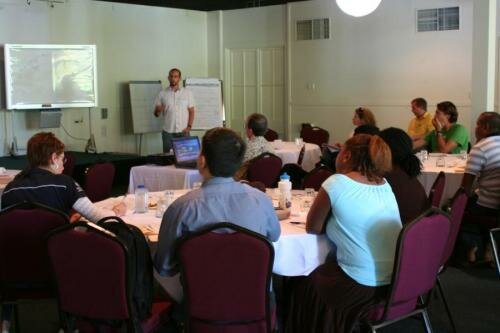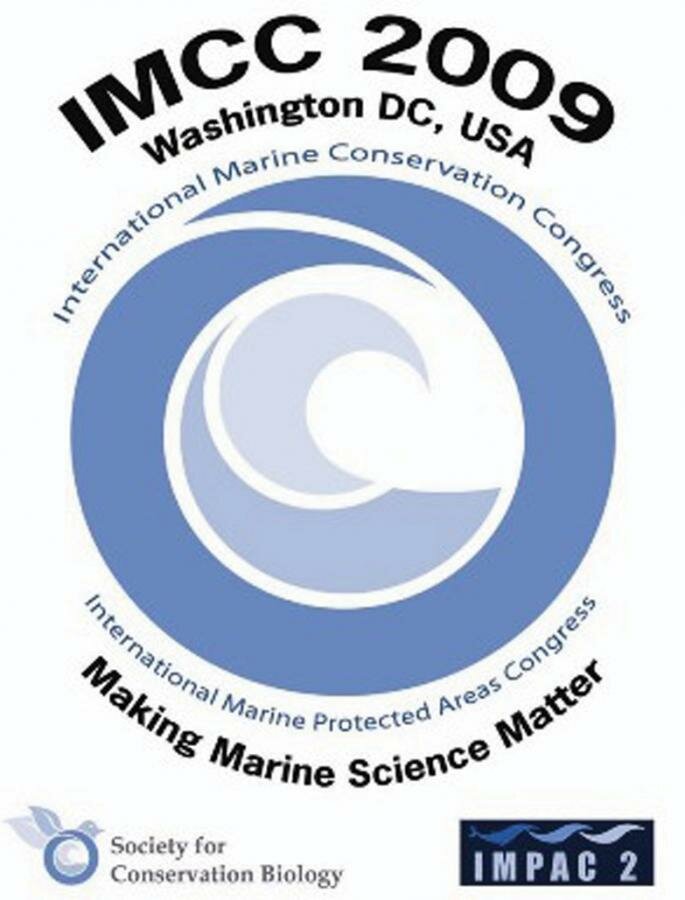Materials from Select Past Training Events
Coastal-Marine EBM Tools Training for Pacific Practitioners | Marine Protected Area and Ecosystem-Based Management Tools Knowledge Café
Coastal-Marine EBM Tools Training for Pacific Practitioners
James Cook University and the University of Queensland in conjuction with the EBM Tools Network Training Program hosted the EBM Tools Training for Pacific Practitioners from August 27-29, 2008, at the Magnetic Island International Resort on Magnetic Island in Queensland, Australia. Fifty-five practitioners from Fiji, Indonesia, Palau, Papua New Guinea, Solomon Islands, Vanuatu, Vietnam, Australia, New Zealand, Canada, and the United States participated in the training. The objectives of the training were to:
- Increase awareness of software tools that can facilitate coastal-marine EBM processes
- Increase effective use of EBM software tools
Training sessions were held in two tracks:
- Track A: Introduction to tools and their functionality, utility, and capacity requirements
- Track B: Tools applications, methods, approaches and techniques

Jorge Alvarez-Romero presents to workshop participants. Photo by Sarah Carr.
Presentations from the meeting can be viewed by clicking on the links below.
Wednesday, August 27
Welcome Presentation by Bob Pressey
Introduction to EBM tools and the EBM Tools Network and overview of workshop by Sarah Carr and Dan Dorfman
Overviews of EBM tools for Marine Protected Area Network Planning, Marine Ecosystem Conservation Planning, Accounting for Connectivity, and Integrated Land-Sea Planning
Marxan and Marzone by Carissa Klein and Matt Watts
Zonation by Dan Segan
C-Plan Ecosystem Planning by Bob Pressey
A land-sea toolkit: NatureServe Vista, CommunityViz, and N-SPECT by Patrick Crist
Marine Geospatial Ecology Tools (MGET) by Jason Roberts
Emerging Tools and Approaches for EBM
Tools for dealing with risk, uncertainty, and climate-driven ecological change by Eddie Game
Return On Investment (ROI) calculations for ecosystem services tool by Michael Bode
Return on Investment by Bob Pressey
Thursday, August 28
Track A: Putting Tools for Marine Ecosystem Conservation Planning and MPA Network Planning into Practice
California MARXAN tool use case study by Carissa Klein
Marine ecosystem management in the Philippines by Rebecca Weeks
MPA networks and ecosystem conservation in Kimbe Bay by Joseph Aisti
Track B: Applying Tools for Integrated Land-Sea Planning
“Interfaces” Approach in Marxan by Matt Watts and Maria Beger
Overview of a land-sea toolkit: NatureServe Vista, CommunityViz, and N-SPECT functionality by Patrick Crist
Marine, terrestrial, and freshwater integrated ecosystem resource conservation planning by Dan Dorfman
Track A: Putting Tools for Integrated Land-Sea Planning into Practice
Framework presentation by Jorge Alvarez-Romero
Watershed Catchment effects on the Great Barrier Reef by Jane Waterhouse
Integrated assessment and planning case study by Patrick Crist
Return on Investment (ROI) case study by Carissa Klein
“Interfaces” Approach in Marxan by Maria Beger
Track B: Applying Tools for Marine Ecosystem Conservation Planning and MPA Network Planning
Overview of relevant Marxan/Marzone functionality by Matt Watts and Eddie Game
Overview of relevant Zonation functionality by Dan Segan
Friday, August 29
Track A: Putting Tools for Accounting for Connectivity into Practice
Coral reef ecosystem connectivity case study by Maria Beger
Hydrodynamic connectivity of coral reefs: a case study by Eric Treml
Track B: EBM Tools for Ecosystem Approaches to Fisheries Management
Overview and demonstration of Ecopath with Ecosim by Villy Christensen
Track A: EBM Tools for Ecosystem Approaches to Fisheries Management
Overview and presentation on fisheries ecosystem modeling with Ecopath and EcoSim case studies by Villy Christensen
Track B: Applying Tools for Accounting for Connectivity
Tools application for coral reef ecosystem connectivity by Matt Watts and Maria Beger
Connectivity tools in MGET by Jason Roberts and Eric Treml
Engaging Communities in EBM and Tool Use
Social network analysis by Ken Vance-Borland
Kimbe Bay case study by Freda Paiva
Philippines case study by Garry Russ
Informal Presentations
Presentations by Chris Bartlett and John Ronneth on marine/coastal resource management in Vanuatu and the creation of a marine reserve network on Nguna and Pele islands
EBM tools in a Community Setting by James Comley

Workshop participants on a bushwalk on Magnetic Island. Photo by Kiki Dethmers.
Marine Protected Area and Ecosystem-Based Management Tools Knowledge Café
Venue: International Marine Conservation Congress in Fairfax, Virginia
Date: May 19,2009
Location: The Bistro, George Mason University
Sponsors: Conservation International and the EBM Tools Network


A wealth of tools exist to assist marine protected area managers and other marine resource managers in addressing the various issues they are tackling, including resilience to climate change, economic incentives, ecosystem-based management and networks of protected areas. Yet accessing this information has been a challenge as institutions and initiatives are dispersed worldwide. The Knowledge Cafe provided an opportunity to access critical tools for MPAs and EBM. Tool providers were available to explain their tool to participants, provide demonstrations of the tools, and discuss tool relevance to attendees’ projects with them. Tools demonstrated included guidebooks, software, websites, models, and integrated tool kits.
Download the Brochure for this Event
Tools being demonstrated:
Coastal Transects Analysis Model (CTAM) (Ratana Chuenpagdee and Ian Ivany, Coastal Development Centre, International Coastal Network) CTAM helps visualize and analyze interactions and flows between natural and human systems, with current emphasis on fisheries and aquatic resources, using information provided by users, literature, and expert judgment. Learn more at www.coastaltransects.org.
Consvalmap.org (Giselle SamonteTan, Conservation International) This interactive website provides an easy-to-use reference to all the economic valuation statistics of tropical marine resources worldwide. Learn more at www.consvalmap.org.
EBM Tools Network Website (ebmtools.org) and Database (Sarah Carr, EBM Tools Network) The EBM Tools Network is a voluntary, international alliance to promote the awareness, development, and effective use of tools and methods for EBM of coastal and marine environments and their watersheds. At this table, we will provide an overview of the range of available EBM tools and the EBM Tools Database. Learn more at ebmtools.org.
Guidebook to Incentive-based Conservation Approaches and Marine Management Areas (Heidi Gjertsen and Eduard Niesten, Conservation International) Heidi and Eduard will share their lessons-learned analysis of a global set of case studies of buy-outs, conservation incentive agreements, and alternative livelihoods projects. They will be available to discuss the applications to your situation and what key issues to consider as you plan your incentive-based conservation strategy.
Integrated Biodiversity Assessment Tool (IBAT) for business (Conrad Savy, Conservation International) IBAT for business is the first output of a shared vision between BirdLife International, UNEP-WCMC and CI, with IUCN acting as an observer. IBAT integrates critical conservation data via web-based tools to facilitate fine-scale biodiversity risk assessment by public and private sector decision-makers. Learn more about the application of this tool to marine-related development planning. Learn more at www.ibatforbusiness.org.
Marine Geospatial Ecology Tools (MGET) (Jason Roberts and Daniel Dunn, Duke University Marine Geospatial Ecology Lab) MGET is a free collection of ArcGIS tools that facilitate the inclusion of ecological and oceanographic data and analyses in MPA planning processes. MGET includes tools for acquiring and manipulating biological and remotely-sensed oceanographic data, building habitat models from field observations of important species, and modeling hydrodynamic connectivity of coral reefs. Learn more at http://code.env.duke.edu/projects/mget.
MarineMap Decision Support Tool (Will McClintock, University of California at Santa Barbara) MarineMap is a free tool that helps stakeholders visualize geospatial data layers, draw prospective MPA boundaries, share prospective MPA boundaries with other users, and generate graphs and statistics to evaluate MPAs on science-based guidelines. Learn more at http://marinemap.org/marinemap.
Marine Integrated Decision Analysis System (MIDAS) (Suchi Gopal, Boston University) MIDAS offers managers and other users of MMAs (marine managed areas) around the world the capability to analyze outcomes that result from the interaction of governance, socioeconomic and ecological factors. The users can input information relevant to their MMAs and quickly visualize the outcomes, including a map of the spatial distribution of risk.
Marine Reserve and Local Fisheries Interactive Simulation (Dan Brumbaugh, American Museum of Natural History) This simulation-based education tool allows users to experiment with the use of marine reserves as tools in fisheries management and to explore various biological and economic factors that influence population viability and fisheries sustainability. It focuses on key Caribbean fisheries species, their habitat preferences, the distribution of these habitats across the seascape, economic costs and proceeds from small-scale fisheries, and simple models of fishing behavior. Learn more at http://ncep.amnh.org/marine_simulation.
MPA EZ – the CCIF MPA Financial Management Tool (Sarah Conway and John Claussen, Conservation and Community Investment Forum) MPA EZ is a free web-and Excel-based tool that provides an overview of an MPA’s current financial situation and helps ensure that resource allocation is in-line with management objectives, financial and physical resources are used efficiently, and financing portfolios are sustainable. Learn more at http://ccif.digitalclouds.net/costmodel/authentication/login.
Open OceanMap (Charles Steinback, Ecotrust) Open OceanMap is a data collection tool used to collect local expert knowledge in support of marine spatial planning. Open OceanMap allows the user to collect and compile ecological and economic data through an intuitive 100-pennies stakeholder interview process. The tool provides interviewees with a web-based interface to review and verify information and aggregates data to ensure confidentiality. Learn more at www.ecotrust.org/ocean/OpenOceanMap.html.
ProtectPlanetOcean.org (Leah Bunce Karrer, Conservation International) This interactive website provides easy access to a wealth of information on MPAs, including a virtual library of marine resource tools ranging from guidebooks to software models to video clips. Learn more at www.protectplanetocean.org.
Practitioner’s Toolkit and Field Guide for Marine Conservation Agreements (Jay Udelhoven, The Nature Conservancy) Marine Conservation Agreements (MCAs) are increasingly being used by NGOs around the world to complement traditional efforts (such as MPAs, area-wide laws and fisheries management) to protect, manage and improve marine biodiversity and ecosystem services. MCAs include any formal or informal understanding between two or more parties in which the parties obligate themselves, for an exchange of benefits, to take certain actions, refrain from certain actions, or transfer certain rights and responsibilities to achieve agreed upon ocean or coastal conservation goals. To help field practitioners understand what MCAs are, determine if MCAs can help them meet their conservation goals, and plan in-water MCA projects, The Nature Conservancy and partners have developed an on-line toolkit and field guide for MCAs. The toolkit and field guide provide information on the basics of MCAs, phases for evaluating and implementing MCAs, country analyses, case studies and resources. Learn more at www.mcatoolkit.org.
Reef Resilience Toolkit (Stephanie Wear, The Nature Conservancy) Developed for coral reef managers, the toolkit provides guidance on how to integrate and build the principles of resilience to climate change into the design of MPAs and daily management activities. The toolkit includes guidance on management strategies such as conserving fish spawning aggregations, MPA network design, and developing coral reef monitoring programs. During the Café, we will review what is available within this new toolkit and share plans for advancing this work via training and practitioners networks. Learn more at www.reefresilience.org.
Social Network Mapping and Analysis for EBM and Conservation Planning (Ken Vance-Borland, Conservation Planning Institute) Many of the insights we get when we reflect on our conservation actions have to do with relationships—who shares information with whom and which individuals are working together. Network maps enable us to track these relationships and then work to improve information flow, innovation diffusion, and collaborative activities by improving the connectivity of individuals in the conservation network. Learn more at www.networkweaving.com/june.html.
For additional information about the Cafe, please contact Leah Bunce Karrer (l.karrer at conservation dot org) or Sarah Carr (sarah_carr at natureserve dot org).
